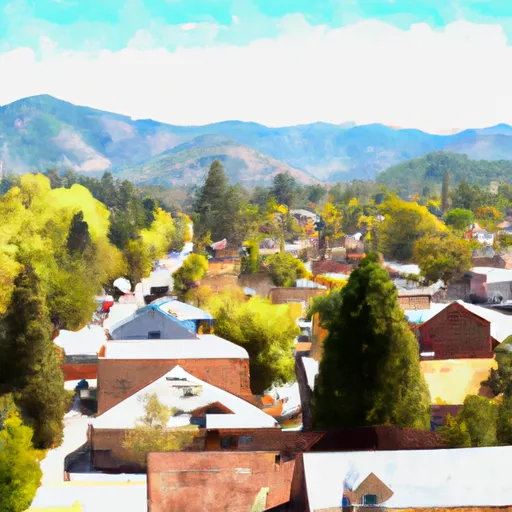-
 Snoflo Premium
Snoflo Premium
Get unlimited access to all our content
With no Ad interruptions! - Start Your Free Trial Login with existing account
Weaverville
Eden Index
Climate
10.0
•
Recreation
7.8
•
Community
2.0
•
Safeguard
7.2/10

Weaverville is a small town located in Trinity County, California. Nestled in the picturesque Trinity Alps, the town experiences a Mediterranean climate with warm, dry summers and cool, wet winters. Summers in Weaverville are typically sunny and warm, with average temperatures ranging from the mid-80s to low 90s Fahrenheit. Winters are mild, with average temperatures in the mid-40s to low 50s Fahrenheit.
The region's hydrology constituents are dominated by the Trinity River, which flows through Weaverville. The river provides ample opportunities for various outdoor activities such as fishing, kayaking, and rafting. It is renowned for its salmon and steelhead fisheries, attracting anglers from far and wide.
Weaverville's proximity to the Trinity Alps Wilderness offers abundant opportunities for outdoor recreation. Hiking enthusiasts can explore numerous trails leading to stunning alpine lakes, granite peaks, and breathtaking vistas. Backpacking, camping, and wildlife watching are also popular activities in this area.
Overall, Weaverville, California, offers a pleasant climate, a beautiful river, and access to pristine wilderness, making it an ideal destination for outdoor enthusiasts.
What is the Eden Index?
The Snoflo Eden Index serves as a comprehensive rating system for regions, evaluating their desirability through a holistic assessment of climate health, outdoor recreation opportunities, and natural disaster risk, acknowledging the profound impact of these factors on livability and well-being.
Climate Health Indicator (CHI): 10.0
Weaverville receives approximately
980mm of rain per year,
with humidity levels near 61%
and air temperatures averaging around
12°C.
Weaverville has a plant hardyness factor of
8, meaning
plants and agriculture in this region tend to thrive here all year round.
By considering the ideal temperature range, reliable water supplies, clean air, and stable seasonal rain or snowpacks, the Climate Health Indicator (CHI) underscores the significance of a healthy climate as the foundation for quality living.
A healthy climate is paramount for ensuring a high quality of life and livability in a region, fostering both physical well-being and environmental harmony. This can be characterized by ideal temperatures, reliable access to water supplies, clean air, and consistent seasonal rain or snowpacks.
Weather Forecast
Streamflow Conditions
Klamath
Area Rivers
Klamath
Snowpack Depths
Klamath
Reservoir Storage Capacity
Klamath
Groundwater Levels
Recreational Opportunity Index (ROI): 7.8
The Recreational Opportunity Index (ROI) recognizes the value of outdoor recreational options, such as parks, hiking trails, camping sites, and fishing spots, while acknowledging that climate plays a pivotal role in ensuring the comfort and consistency of these experiences.
Access to outdoor recreational opportunities, encompassing activities such as parks, hiking, camping, and fishing, is crucial for overall well-being, and the climate plays a pivotal role in enabling and enhancing these experiences, ensuring that individuals can engage in nature-based activities comfortably and consistently.
Camping Areas
| Campground | Campsites | Reservations | Toilets | Showers | Elevation |
|---|---|---|---|---|---|
| East Weaver | 11 | 2,692 ft | |||
| Sheill Gulch | 9 | 2,797 ft | |||
| Tunnel Rock | 6 | 2,025 ft | |||
| Douglas City | 20 | 1,613 ft | |||
| Mary Smith | 18 | 1,909 ft | |||
| Deerlick Springs | 13 | 3,230 ft | |||
| Steel Bridge | 9 | 1,698 ft | |||
| Junction City | 22 | 1,459 ft | |||
| Steiner Flat | 8 | 1,609 ft | |||
| Basin Gulch | 19 | 2,589 ft |
Nearby Fishing
Nearby Ski Areas
Catastrophe Safeguard Index (CSI):
The Catastrophe Safeguard Index (CSI) recognizes that natural disaster risk, encompassing floods, fires, hurricanes, and tornadoes, can drastically affect safety and the overall appeal of an area.
The level of natural disaster risk in a region significantly affects safety and the overall livability, with climate change amplifying these risks by potentially increasing the frequency and intensity of events like floods, fires, hurricanes, and tornadoes, thereby posing substantial challenges to community resilience and well-being.
Community Resilience Indicator (CRI): 2.0
The Community Resilience Indicator (CRI) recognizes that education, healthcare, and socioeconomics are crucial to the well-being of a region. The CRI acknowledges the profound impact of these elements on residents' overall quality of life. By evaluating educational resources, healthcare accessibility, and economic inclusivity, the index captures the essential aspects that contribute to a thriving community, fostering resident satisfaction, equity, and social cohesion.

